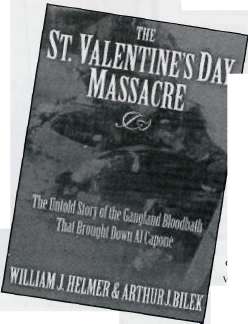 |
Home | Search | Browse | About IPO | Staff | Links |
 |
Home | Search | Browse | About IPO | Staff | Links |

Bloody valentine The St. Valentine's Day Massacre: The Untold Story of the Gangland Bloodbath that Brought Down Al Capone In my early teens I went to Italy with my father. While we were waiting for a cab, a short, dark-haired Italian man asked us in halting English where we were from. When my dad told him, "Chicago," the man made his hand to look like a gun and said "bang, bang." Sixty years and 2,000 miles had done little to diminish Chicago's grisly association with gangland violence and Al Capone. The St. Valentine's Day Massacre: The Untold Story of the Gangland Bloodbath that Brought Down Al Capone, brings Capone's notoriety and deep association with Chicago and environs clearly into focus. In this first full-length study of the massacre, the authors put forth two key points. The principal argument is that the St. Valentine's Day Massacre was the beginning of the end for Al Capone. The number of people killed (seven) was the most at the time—and since—when it came to gangland killings. The murders brought a lot of unwanted attention to Capone. Before long he was declared public enemy number one in Chicago. His mug was featured on the cover of a national publication, Time. A secondary argument is that the Thompson submachine gun made its debut and claimed it first victim in Chicago. A significant contribution of the book is the emphasis the authors place on the role of the so-called "American boys" in the infamous crime. The American boys came to Chicago from St. Louis. A major obstacle to solving the St. Valentine's Day Massacre was that the killers were unfamiliar to the Chicago police and the city's newspaper reporters. This particular contribution to the literature is in no small part the result of the authors' use of one important source—the memoir of Georgette Winkler, the wife of Gus Winkler, one of the American bovs who participated in the massacre. The authors do an excellent job describing and explaining the evolution of the conflict between gangs on the North Side and the South Side, and how this feud came to a head in a garage on North Clark Street. Readers will have a better understanding of the ascent of organized crime in Chicago, and how this served as a backdrop to the personal rise and fall of Al Capone. For readers familiar with Chicago and the suburbs, the book is all the more enjoyable as the authors include the addresses and locations of people and events described in the text. What is a strong point is at the same time a lost opportunity: The book would have been enhanced had it included a street map of Chicago with bullet points marking the addresses. The inclusion of Frederic Thrasher's 1926 "Gangland Chicago" map and the 1931 Bruce-Roberts, Inc. map of "Chicago's Gangland" would have illustrated to readers not only that gang activity and violence went beyond the North-South dispute, but also that Chicago's gangland was as widespread geographically as it was culturally. Even without the maps, experts on gangland Chicago, as well as general readers, will enjoy this interesting and well-researched book. —Christopher J. Young Christopher J. Young is an assistant professor of history at Indiana University Northwest. 30 Illinois Heritage |Home|
|Search|
|Back to Periodicals Available|
|Table of Contents|
|Back to Illinois Heritage 2007|
|